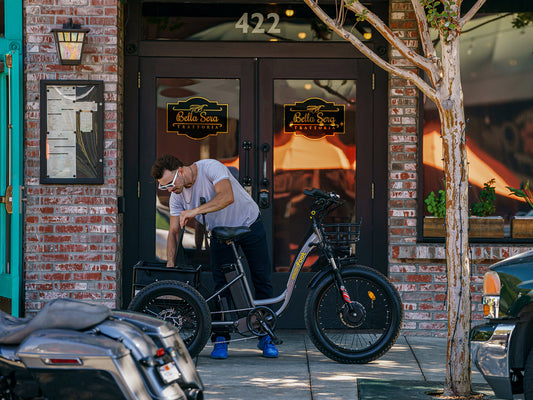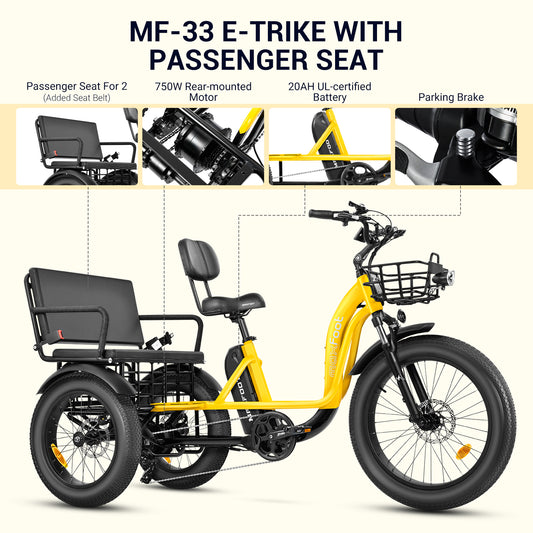The clouds gather menacingly overhead, the wind starts to rise, rustling the leaves and churning the sky into a tempest. Suddenly, the first droplets begin to patter on your helmet as you pedal onward, hands gripping the handlebars of your electric bike.
Questions inevitably swirl in your mind - are e-bikes safe to ride in the rain? Will the water damage your bike's components? Is there any risk of an electrical short?
Answering the first question, yes electric bikes are safe in rain as they are designed to handle moderate rainfall. However, it's essential to understand the nuances of e-bike construction, maintenance, and safe riding practices to ensure a worry-free ride, even in inclement weather.
Understanding E-Bike Construction
Electric bikes, like their traditional counterparts, are engineered to withstand a wide range of weather conditions, including rain. The critical electrical components, such as the motor, battery, and controller, are typically sealed off to prevent water ingress.
Nonetheless, not all e-bikes are created equal. They range from splash-resistant to fully waterproof, depending on the manufacturer's design and the quality of the materials used.
Therefore, most e-bikes can handle a light drizzle or a moderate downpour, however, prolonged exposure to heavy rain could potentially lead to damage.
How to Read Ingress Protection (IP) Rating?
The degree of water resistance in an e-bike is denoted by an Ingress Protection (IP) rating. This rating consists of two digits: the first indicates the level of protection against solid particles (like dust), and the second, more crucial for our topic, signifies resistance to liquids. E-bikes with a higher second digit in their IP rating offer better protection against water.

Normally, the e-bike parts have a rating of IP45 to IP66, which indicate they are somehow fully resistant to dust while only provide a certain level of resistance of against water.
It's always advisable to check this rating before purchasing an e-bike or if you plan to ride frequently in rainy climates.
How to Ride an E-Bike in Rain: 6 Helpful Tips
Riding in the rain involves more than just the bike's resilience to water. Safety should always be paramount, and wet conditions invariably increase the risk of accidents. Here are some tips to ensure a safe ride:
- Improve Your Visibility: Equip your e-bike with high-visibility lights and reflectors to ensure you're seen by other road users.
- Wear Waterproof Clothing: Invest in waterproof jacket and trousers to stay dry and comfortable during your ride.
- Keep Safe Distance:The braking distance tends to increase in the wet, so maintain a safe distance from vehicles and pedestrians, and always brake earlier than you would under dry conditions.
- Seek Nearest Shelter: In case of a heavy downpour, seeking shelter should be your immediate priority. Look for nearest public building, bridges, canopies and awnings.
- Clean Your E-Bike After Each Wet Ride: Thoroughly cleaning your e-bike after the rain through ride will help to remove any grit or dirt that could cause premature wear and tear.
- Let the Battery Dry: If your battery gets wet, ensure it is completely dry before recharging to prevent short-circuits.
The Electrical Perspective
In terms of the electronic risk, the danger of electric shock from e-bikes is extremely low, even in rainy conditions. The voltage used in e-bikes (typically between 24V to 48V) is generally not high enough to penetrate human skin, the body's natural resistance.
Furthermore, the entire electrical system is DC (Direct Current), which is much safer than AC (Alternating Current).
Maintaining Your E-Bike for Rainy Conditions
Routine maintenance is also crucial to keeping your e-bike safe for wet rides. Regularly checking seals, gaskets, and housing units for any signs of wear and tear can help prevent water intrusion into the electrical systems.
After riding in the rain, it's essential to thoroughly dry the bike and keep it in a dry and warm place to ward off potential rust and corrosion.
Final Words
Although electric bikes are built to withstand rainy weather, it's essential to respect Mother Nature's potential for sudden downpours. Regular maintenance, understanding your bike's water resistance, and following safe riding practices significantly contribute to a safe and enjoyable e-biking experience, rain or shine.
If the rain becomes too heavy or the road too treacherous, consider finding shelter until the worst of it passes. Enjoy the freedom that your e-bike offers, but remember that part of that freedom is knowing when to hit the brakes.




